Eyeglasses, Posture, and Headaches
Vision and headaches
We know that challenges with our vision can cause headaches. Squinting in bright light or straining the eyes to bring hazy text into focus can easily result in strain or pain in the eyes, temples, top of the head, or elsewhere.
What is less widely acknowledged is that wearing prescription glasses can also cause headaches. An overlooked cause of headaches—and other pains too—is the poor posture we often adopt when wearing glasses. In this post I will be looking at the posture traps to avoid with eyewear—and how to turn wearing glasses to your postural advantage.

Wearing glasses can solve headaches—or cause them if they lock you into poor posture. Pexels
The eye test
Let’s start with the eye test. Your optician or ophthalmologist uses various machines to measure eye pressure and light refraction, and to look at the cornea, iris, lens, and retina of the eye in microscopic detail. During these examinations you want to bring the apparatus as close to you as possible, and/or hinge at the hips to angle yourself forward. Apply the “spoon to your mouth, not your mouth to the spoon” principle; rather than jut your neck out for extended periods, minimize distortion to its delicate structures.
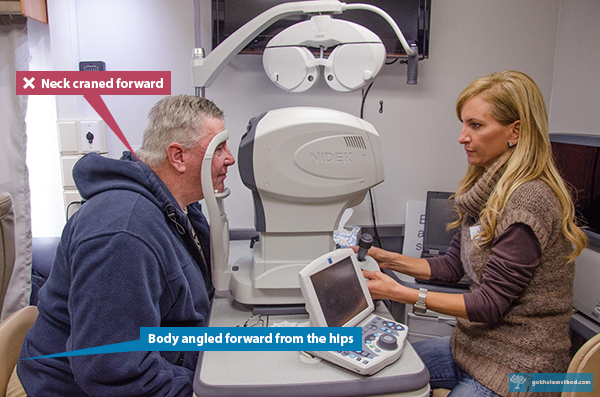
Various types of eye examination will require you to crane your neck forward to rest your chin
and forehead against supports. Wikimedia
Getting fitted for your glasses
Always be in your best possible position when you get your glasses fitted. Your optician or optometrist is an expert in eye care, but not in posture. They will likely overlook any degree of slump (or sway) in your back, and the resulting compensatory chin lift, and fit your glasses accordingly. In this way, they will unwittingly build in a bias that compresses your neck.
You want your head “back home," as it was when you were a young child. Let your chin angle down, your neck be tall, and your head be back, aligned over your body. You can learn how to lengthen your neck and restore healthy alignment here. This will direct your gaze more down your nose. Maintaining healthy posture while choosing and wearing your glasses will avoid compression and the wear and tear and headaches it brings.
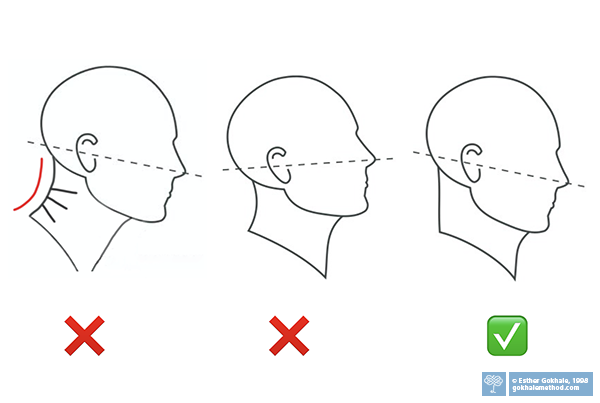
Avoid both letting your head drift forward (left) and lifting your chin (center), both of which compress the nerves, discs, bones, and tissues in the back of the neck and are a common cause of headaches and degenerative changes in the cervical spine.
Progressive lenses call for progressive posture
Progressive lenses are a great boon for many wearers. These lenses can combine several prescriptions in one, allowing you to focus on things near, far, and in between, regardless of what distance your eyes do best. For example, a progressive prescription for farsightedness, a common condition as we get older that makes close work like reading difficult, will have a stronger magnification at the bottom of the lens which makes it perfect for close-up tasks such as reading phones and books—or laptops and tablets—or, a little further away, working at the kitchen counter. However, there are particular posture considerations when it comes to progressive lenses:
- If you have your chin up when you are measured for a progressive prescription, then you will be obliged to hold this compressed, chin up position whenever you need to see things up close—which could be for hours at a time. Additionally, you are training yourself to compress your neck as a baseline position.
- If you use progressive lenses for close-up work ahead of you, such as looking at a desktop computer screen or reading sheet music (or conducting an eye test!), you will be obliged to lift your chin to peer through the “sweet spot.” We strongly recommend having a pair of “computer glasses” which enable you to position your head in a healthy position.
- If your vision deteriorates further and you do not update your prescription, you will be obliged to increasingly lift your chin to peer through the greater magnification lower in the lenses. It is therefore important to have your eyes tested regularly.
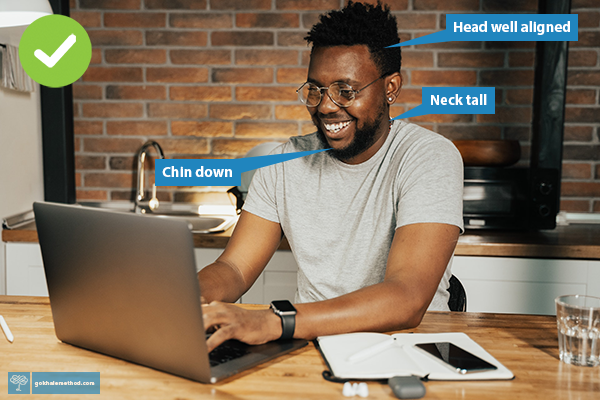
Progressive lenses can work well for looking down at books, tablets, and laptops. Pexels
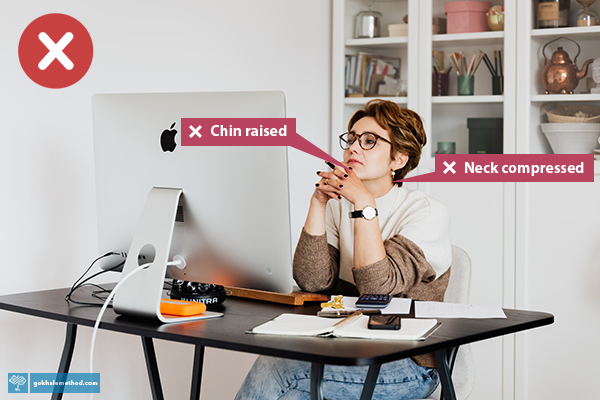
Relying on the reading area at the bottom of a progressive lens will lock you into poor posture at a desktop computer. Pexels
Bending forward or down
You want your frames to fit your head and the bridge of your nose perfectly, so that you won’t tip your nose up to keep them from sliding off. Test the glasses properly for size and grip when you buy them. A good optician will be able to make adjustments to most frames to fit you optimally.

Don’t let poorly fitting glasses compromise your bending, making you round your back and crunch your neck.
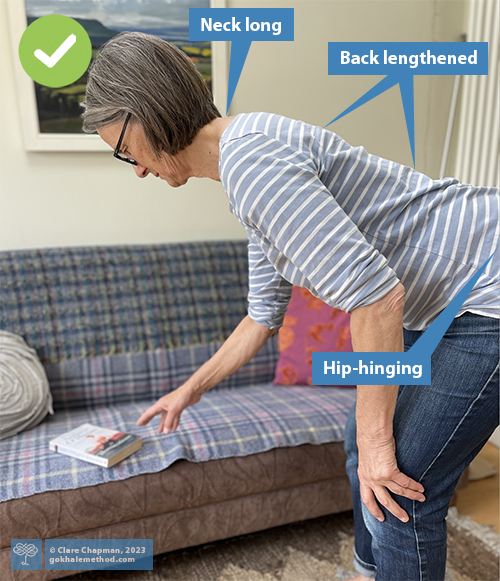
You want to hip-hinge as well as you know how, maintaining length through your spine.
Choose larger lenses
Habitually seeing the world through lenses, even sunglasses, tends to somewhat limit the movement of the eye and increases our reliance on turning the neck. Infants and people in traditional societies show a preference for bigger eye movements rather than bigger neck movements.

This young girl at school in Otavalo, Ecuador, moves her neck a little—and her eyes a lot. You can read more about eye tracking here.
We recommend you choose good-sized lenses that lessen the tendency to “tunnel vision," and avoid thick frames that block your peripheral vision. Contact lenses can go a long way to restoring this freedom, so you may want to consider them too.
A well-fitted pair of glasses can even be a reminder to find your best head, neck, and body alignment. Muster all the elegance you might bring to wearing a crown.
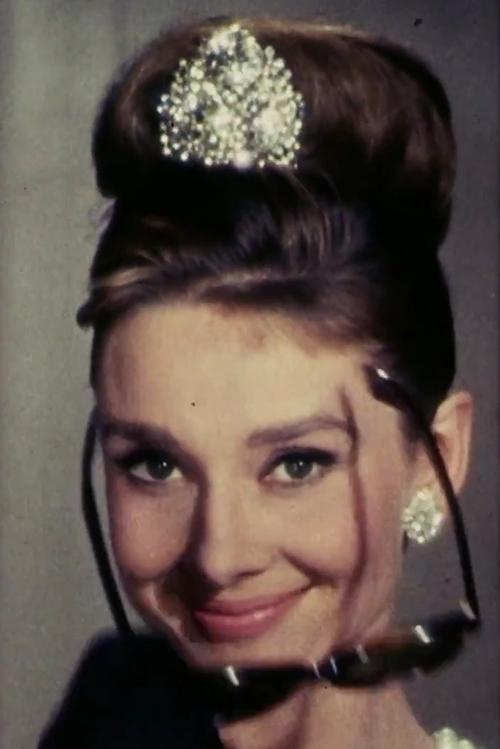
Audrey Hepburn knew how to use both her eyes and her sunglasses to good effect—and with strikingly good posture! (from Breakfast at Tiffany's). Wikimedia
Best next action steps for newcomers
If you would like insight on your posture, consider scheduling an Initial Consultation, online, or in person.
We are offering a Posture Remedies for Text Neck Free Online Workshop on June 1 at 4 p.m. PST. You can sign up below to join any of our upcoming FREE Online Workshops.

Comments
Add New Comment
Login to add commment
Login